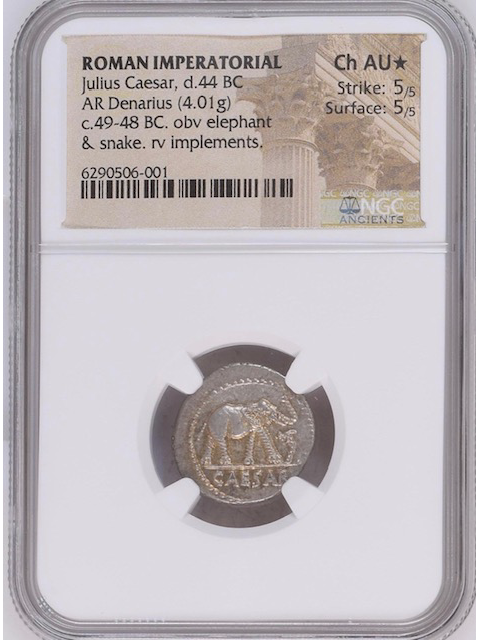鋳造時期: 紀元前49年〜48年
鋳造地: 北イタリア
重量: 4,01グラム
直径: 19ミリ
表面: 象(エレファント) 、ホーンド・ サーペント(2本の角を持つ蛇)、「CAESAR」
裏面: culullus (ウエスタの処女/巫女:Vestales Virginesの象徴で、ワインやミルク用) aspergillum (アスペルギルムは、聖なる水を蒔くための「典礼用具」)、securis (Securis Victimaria: 聖具で人肉と骨をバラバラにするための斧、上に犬か狼の頭), Apex。
NGC鑑定番号: 6290506-001
NGC鑑定結果: Choice AU ★ 5/5 - 5/5 !!!
同グレードの過去のオークション歴:
Heritage Auction Galleries 2021年5月7日 Lot 32152 (全く同じGradeで:9600ドル)、同Heritage 2021年8月20日 (Lot34166) 上級のCh Ms ですがSTARなしで:15600ドル。
参考専門書: Crawford 443/1. Sydenham 1006. Julia 9
特記: 「エレファント」Denarius銀貨の9割近くが、4グラム以下で、本品が4グラムを超えています。
共和政ローマ末期(紀元前49年):
「ルビコン川を渡る」や「賽は投げられた」の時期に鋳造されたコイン!
紀元前49年1月10日-11日、カエサルとその軍隊がルビコン川を渡り、ローマ内戦開戦時の「ルビコン川を渡る」同時に「Alea jacta est : 賽は投げられた」という言葉とともに知られている。
カエサルが他人に任せたのではなく、自らで「注文」したこのコインの表面にある「象」は 、「善」を意味して、「蛇」は「悪」。
「悪」を踏み潰す「善」である「象」の勝利を描いたこのコインは、歴史的に最も有名。
Produced during the time of Julius Caesar's crossing the Rubincon.
This war brought about the end of the Roman Republic.
The obverse features an elephant facing right, crushing under its massive foot a horned serpent with 'CAESAR' below this scene.
The reverse carries the symbols of the Pontifex Maximus, the high priest of Rome.
The pontifical implements found on the reverse are:
1: Ladle for use in sacrifices (simpulum)
2: Holy-water sprinkler (aspergillum)
3: Axe adorned with animal imagery (securis)
4: Pontif's hat (apex).
It was on 10 January 49 BC that Caesar and his armies were assembled on the banks of the Rubicon river, poised to attack Italy.
Large amounts of denarii were needed to pay military expenses.
Therefore the military mint traveled along with Caesar and his armies. This coin was not ordered by a moneyer, as was usually the case, but by « Julius Caesar » personally.
The obverse is a piece of numismatic propaganda: the triumph of good (the elephant) over evil (the serpent) !!!
It was crafted to encourage Caesar's warriors during the long, grueling military campaign. It is the view of some scholars that employing the image of the elephant suggests that Caesar considered himself an equal of famous generals such as Alexander the Great and Hannibal.
This coin is usually dated to 49 B.C, the year Caesar took large quantities of gold and silver from the treasury in the Temple of Saturn in Rome.
This metal was in all probability used to fund his new denarius.
